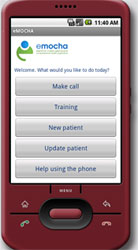Hopkins program taps into Uganda’s technology resources
November - December, 2009 | Volume 8, Issue 6
Two limitations that global health workers in developing countries frequently face when implementing new distance learning and informatics programs are insufficient communications infrastructure and the lack of timely feedback regarding the effectiveness of the research and training being conducted.
A platform that bridges these gaps is Johns Hopkins University's Electronic Mobile, Open-source, Comprehensive Health Application, or eMOCHA.

Photo courtesy of Johns
Hopkins University
Dr. Robert Bollinger, a Fogarty informatics grantee, and his team have been spearheading efforts to create tools for distance learning programs in low-resource settings in India and sub-Saharan Africa. Though many of the platforms his team has developed have been based on more traditional technologies such as web, CD-ROM and teleconferencing, eMOCHA relies on the use of mobile phones to transmit and receive instructional data.
"Wireless access all over Africa is ubiquitous," said Dr. Bollinger. He and his colleagues discovered that Uganda is no exception, with powerful 3G capacity in 80 percent of the country. 3G, or 3rd generation, refers to coverage that allows simultaneous use of speech and data services, with higher data rates than previous generations. This coverage is particularly well suited for mobile health training projects because it allows users to send large files such as databases and video.
The eMOCHA platform is currently being used by PEPFAR, and connects 17 partners throughout Uganda. The program's nerve center is at Mulago hospital in Kampala, which has a group of local experts, a server base and a decent fiber network. If the researchers at Mulago need to improve treatment of diseases in Uganda's rural areas, they develop and send out tools, such as touch-screen data forms. The forms are received on android-supported smart phones and the response data is sent back to the server.
The program has proved to be effective because of its speed and accuracy. Data that is sent to the server can be linked to global positioning system coordinates and plotted on a map, allowing experts to analyze the data and identify training gaps. If the programs aren't having an impact, says Dr. Bollinger, the Mulago team responds by pushing out new training data to the phones and starting the cycle again.
"Building on that experience and that loop, we can continue to empower people locally as well as impact the outcomes we're interested in," said Dr. Bollinger. "We're building a toolbox of different tools for distance learning, including eMOCHA, but our ultimate goal is to hand off that toolbox to people in India, Uganda and other places."
More Information
To view Adobe PDF files,
download current, free accessible plug-ins from Adobe's website.